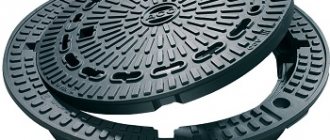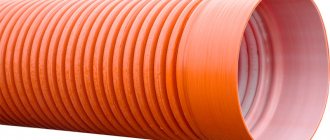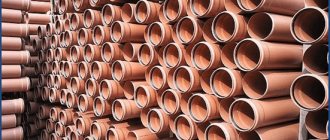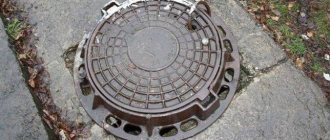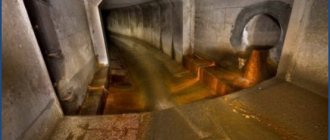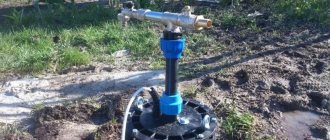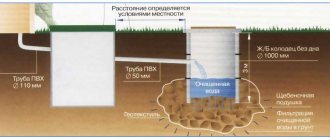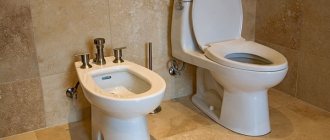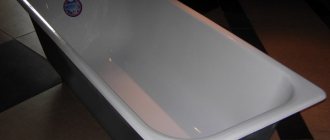What is a polymer sewer manhole: dimensions and diameter? How much does a well cover weigh? Cast iron hatch. Let's look at it in detail with tables and examples.
Sewer hatches are special devices designed to protect the sewer system from dirt and debris, as well as from possible damage. One of the popular materials used for the production of hatches is polymer. Structures made using polymers can withstand loads of up to 20 tons. Also, the popularity of the material is ensured by the fact that the manufacturer can produce any size of sewer hatch.
Advantages and disadvantages of polymer hatches
In addition to the already mentioned advantage of being able to withstand loads, products made from polymers have a number of other positive qualities.
The list of advantages includes characteristics:
- Price;
- Long service life, reaching up to half a century;
- Light weight, ensuring ease of transportation to the installation site, and no need to involve special equipment or use additional tools for installation;
- The environmental friendliness of the finished product is ensured by the use of polymer and sand in the production process;
- High elasticity value, which significantly reduces fragility;
- Lack of metals in the composition, which makes the product unattractive to scrap metal collectors;
- Resistance to corrosion;
- The use of high-quality heat-resistant pigments, as well as special components, allows protection against fading in the sun and the negative effects of ultraviolet rays;
- The ability to purchase the product in any color, which significantly expands the number of places for use;
- Resistance to temperature changes.
The main disadvantage of polymer products lies in the fact that such products are not suitable for installation on highways. Heavy vehicles constantly move along such roads, and polymer elements will not be able to withstand a load exceeding the previously specified 20 tons.
Material of manufacture
Today, cast iron hatches are most often found, since for a long time there was almost no alternative to the material. Concrete and steel products were occasionally used. Plastic lids have appeared recently, but they are expensive. Polymer ones are cheaper and superior in quality to plastic.
Cast iron
When the hatch is subjected to increased mechanical and weight loads, cast iron is the optimal solution. The service life of a product made from it is more than a century; it does not deform from frost or heat. Significant disadvantages of cast iron hatches are their large mass and high price.
At the enterprises, the lid and neck are cast, which can be with a cast iron rim and a concrete base. Some modern models are equipped with rubber gaskets. The metal of the body is less durable, the lid is stronger. The design can withstand heavy loads.
In home sewers, hatches are located where they are not subject to intense loads. Therefore, it is more rational to use models made of lighter and cheaper materials. Cast iron products are heavy, making them difficult to open.
Cast iron sewer hatch.
Polymer
In parks, garden paths, and cottages, polymer and plastic covers are more common. Plastic is an expensive material and is inferior in strength and durability to polymers. Large plastic covers are rarely found; small inspection hatches are mostly used.
Polymer sand products have become widespread. This is a synthetic material for the manufacture of which a special technology is used: 30% polymers, 69% fine sand and 1% iron oxide are mixed. The production uses recycled materials from plastic bottles, etc., so the products are cheap. After adding sand and heat treatment, the mass is pressed and cooled. Strength is increased by incorporating reinforcement into rings and caps.
Manufacturers pay great attention to the decorative design of lids. They are colored by adding pigments. Color camouflages the product or, conversely, attracts attention, signaling danger. The lids are often made in relief, with patterns and ornaments.
Polymer hatches are easy to use: they open and close easily and do not freeze to the neck in winter.
They have much less weight than cast iron lids, but they are much inferior in their ability to withstand loads. Therefore, polymer and plastic products are not installed on roads with heavy traffic.
Polymer hatch.
Structures made from other materials
Concrete hatches are most often used in the construction or renovation process . They are a reinforced concrete slab with protruding brackets with which it is moved.
If the product is of non-standard size or shape, it is covered with a reinforced concrete cover. In home sewers, these hatches are used to ensure the tightness of a well made of concrete rings or a rectangular monolith. Such products are made to individual orders.
Steel hatches are almost never used, because they are heavy, inconvenient, and rarely provide tightness. These products are used primarily as a second inner cover in shafts containing electrical and telephone cables. They are equipped with locks.
Shape of polymer hatches
According to the produced form, polymers are:
- In the shape of a square;
- In the shape of a circle.
types
Since, according to the design features of the underground well, the shaft has a round shape, the lid for it will be the same. This type allows you to prevent various debris from entering the sewer system, causing an emergency situation. In addition, the circle-shaped lid will not fall into the shaft.
But the square analogue easily falls inward if there is significant physical impact on it.
Specifications
When choosing a polymer lid, you should definitely pay attention to each technical characteristic of such a product. The main features are considered to be:
- Weight (this parameter is especially important);
- Type;
- Rated load.
It is important to have an idea of the permissible load class of the product, because the maximum value of the load that the product can withstand without damage depends on this parameter. Also, this value influences the choice of installation location. For example, a cover belonging to type “L” is a lightweight product that can withstand a maximum load of one and a half tons. Accordingly, such covers are not allowed for installation on the roadway. To close the drainage system shafts in courtyard driveways or parking lots, medium and heavy structures are used. Such products can easily withstand loads ranging from 15 to 25 tons.
You may also like: Sewer well - types and design
What you can do yourself
A cover for a well located on your own personal plot can be made with your own hands, but this is a narrow application of a single element of the well and materials available. Sewer manhole covers are purchased from a factory, even for individual use.
Manhole cover matches the color of the lawn
So:
- Any plastic sewer manholes are interchangeable, and you can install them yourself on your site.
- A modern polymer lid can be installed in a metal case.
- The waterproof material can withstand sufficient loads, and multi-colored paints give the lid an aesthetic appearance.
- The inner side of the plastic covers is reinforced with stiffening ribs.
- They are characterized by an acceptable price and lightweight.
- They are easy to install and dismantle.
The type of design is determined by the place of its use, but in all cases, the plastic hatch has significant advantageous characteristics that allowed them to gain wide popularity among potential consumers.
Classification by type of construction
As noted above, sewer manholes are classified according to the permissible load. The list of product types is as follows (data on how much the sewer hatch weighs is also indicated here).
| Construction type | Installation location | Permissible load | Product weight |
| Garden (type L) | Pedestrian sidewalks; Green areas. | 1500 kg. | 25 kg. |
| Light (type L) | Car parking; green areas; pedestrian sidewalks. | 3000 kg. | 45 kg. |
| Medium (type C) | City parks; Vehicle parking. | 7500 kg. | 52 kg. |
| Heavy (type T) | Roads with moderate vehicle traffic | 15000 kg. | 57 kg. |
| Heavy trunk (type TM) | Roads with heavy traffic | 25000 kg. | 60 kg. |
It is worth noting that the weight of a cast iron sewer manhole will be significantly greater than the weight of the polymer product.
Introduction
Introduction
The standard specifies the types of hatches, the strength loads that hatches and installation locations must withstand, identical to the European standard: hatch L - class A15; hatch C - class B125, etc. This connection is reflected in the designation of hatches and rainwater inlets: hatch L (A15); storm water inlet DM1 (S250). The dimensions of the storm drain grate grooves and their location in relation to the curb stone are harmonized with the EN 124-1994 standard. Participating in the development were: M.Yu. Smirnov, S.V. Tsygankov (Kirov Plant OJSC, Kaluga region), V. A. Glukharev and V. P. Bovbel (Gosstroy of Russia), L. S. Vasilyeva (GP CNS), Yu. M. Sosner.
Dimensions
According to the given classifications by shape and type of construction, polymer sewer manhole sizes are:
- Lightweight and able to withstand a maximum load of up to one ton, the body size is 720x60 and the dimensions of the lid itself are 600x25.
- Lightweight products that can withstand a load of up to two tons have a body size of 750x90. The lid size in this case is 690x55.
- Hatches (light), withstanding a load of up to two tons and produced in the shape of a square, are 640x640 in the body. The lid itself measures 600x600.
- Lightweight products that can withstand loads of up to five tons: body - 750x90, cover - 690x55.
- Medium, withstanding a load of up to 15 tons: body - 750x100, cover - 690x50.
- The class of heavy products with a maximum permissible load of 25 tons has body dimensions of 800x110, and covers of 700x70.
The cast iron sewer hatch dimensions will be identical to the above values.
It is important to understand that light covers can be mounted at a depth of up to 45 millimeters, medium ones up to 60 millimeters, and for heavy ones this value is up to 85 millimeters.
According to current standards, the diameter of the sewer manhole depends on the shape of the product. Thus, the diameter of a round sewer manhole is 1.88 meters. Of course, the diameter of the manhole cover will be an order of magnitude smaller.
General information
Lids are made from
- Cast iron. Such hatches are installed in areas with heavy loads. The material is very strong, heavy, durable.
- Polymers. Used for installation in private homes and park areas.
- Concrete. Products made from this material are heavy and have poor sealing properties, but they are great for non-standard necks.
Manufacturers offer hatches of different shapes
- Round
- Square
- Triangular
- Oval
- And all kinds of covers of non-standard geometric shapes.
Triangular, oval and “exclusive” are extremely rare. Square and rectangular ones can be seen more often. The vast majority use round hatches. They are the easiest to install. Round cast iron sewer manholes have a diameter from 380mm to 810mm.
Polymer round caps are available with a diameter of 315-1000mm. Square products are offered with rib lengths from 300mm to 800mm, dimensional increments of 50mm.
Plastic hatches
Polymer hatches are marked in the center of the cover - a letter.
- V-plumbing
- G-hydrant
- K-sewer
- D-rain inlet
- TM-highway automobile
- TS-heat network
- GS-gas network
- GKS-city cable network
- GTS - city telephone network
Knowing the designations makes it easier to choose the right cover for the well.
Attention. When choosing a round hatch, two indicators should be taken into account: internal and external diameters. The diameter of the neck must be the same as the inner diameter of the hatch. The correct diameter ensures a sealed installation.
Sewer cover sizes
| Model | Class | Weight, kg) | Load (kg) | Application area | Serve (years) | dimensions |
| garden | A15 | 11 | 1500 | Park, garden, private house, cottage. | 50 | 540*540*80 |
| Green lungs | A15 | 10 | 1500 | Park, square, country house. | 20 | 750*750*80 |
| With locking device | A15 | 46 | 1500 | Pedestrian areas, parks. | 20 | 780*789*110 |
| Small-sized | A15 | 25 | 1500 | Park, light, pedestrian area. | 20 | 730*730*60 |
| Plastic lungs | A15 | 44 | 3000 | Inspection wells, parks. | 20 | 750*630*115 |
| Road averages | B125 | 50 | 12500 | Highways, sidewalks, parking lots | 50 | 780*780*110 |
Plastic products
- Light weight
- Do not rust
- Don't rot
- Resistant to aggressive environments
- Easy to install
Cast iron hatches
Cast iron covers are cast from SCh45, and the body is cast from SCh15. Sometimes a rubber gasket is installed between the hatch and the neck. The gaskets are made of high-strength rubber, which retains its properties for a long time.
The service life of cast iron covers is up to 100 years or more. Cast iron is not subject to deformation due to temperature changes, for this reason the destruction of the neck is minimized. The main disadvantages of cast iron hatches are that they are difficult to install and the covers are often stolen, and they are not cheap.
All products are manufactured on the basis of GOST. You can install the polymer hatch yourself. But you will have to install a cast iron or concrete cover with an assistant or use special equipment.
This is interesting: Types of septic tanks for home and garden - classification of treatment plants
Installation Features
Installation of a polymer sewer cover is identical to the list of works that are performed when installing a cast iron product. The main difference lies in how much the manhole cover weighs. Naturally, metal is much heavier than plastic. This means that you won’t have to hire help to install the polymer structure.
When the required hatch option has been selected, you can begin to work:
- First of all, the ring is installed on the cover of the sewer shaft. This part is very often called the shell. Here it is important to check in advance that a support ring is installed between the shaft cover and the hatch. This element allows you to reduce the load directly on the slab by three times. Instead of a factory part, you can use a masonry installation. However, the brick crumbles over time and the lid may fail. Here it is important to remember how much a sewer hatch weighs in order to choose the right method for arranging the support.
- To achieve the ideal installation of the ring, which serves to distribute the load, it is worth resorting to the help of a building level. It is strictly forbidden to mount the structure at an angle, because such actions will lead to subsidence and deformation.
- Next, the ring is filled with concrete mortar around the entire perimeter of the outer side.
- For the last stage of work, it is necessary to wait until the concrete mixture has completely hardened.
- The installation is carried out directly into the ring. In this case, it is quite important to treat the working surface with grease or lithol. These substances are capable of ensuring 100% opening of the well even at negative temperatures outside the window.
Popular brand
Sewer hatches from the German company ACO are ideal for Russian conditions.
They are distinguished by reliability, practicality and solid appearance.
ACO covers are made of anti-corrosion cast iron alloys with high wear resistance and resistance to aggressive reagents, petroleum products, and wastewater. The unique material allows you to create products with a high tensile strength. Neck frames can be made of plastic concrete or cast iron.
Fig.8. ACO manhole.
The advantages of ASO products are the presence of anti-vandal fastenings with which the covers are attached to the necks of the structures.
Locks protect against unauthorized entry and prevent lid theft.
The ACO brand presents round and square sewer manholes for various purposes, with blind covers or with storm inlet openings.
The ACO company has developed a modern technology for installing sewer manholes in asphalt using the Bituplan system. The advantage of this method is the installation of hatches without the use of mortar. With this method, the load is distributed evenly across all elements of the system. The hatches are installed exactly at the same level with the asphalt surface, which prevents shocks when hitting the structure.
Thanks to the presence of sealing inserts made of elastic materials, silent passage of vehicles through the hatches is ensured.
